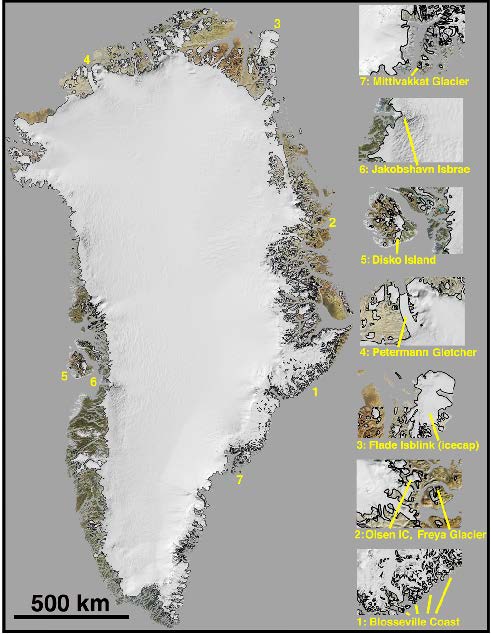The EGU is pleased to announce the launch of its Twitter Journal Club, a regular, interactive online discussion about a timely scientific article. Full details can be found here.
Our first ever article, described below, covers a climate change related blunder made by The Times Comprehensive Atlas of the World and the swift response of an international group of scientists. The Twitter discussion will take place on Thursday 21 June at 17:00 CEST (hashtag #egutjc1). Please email the EGU’s Science Communications Fellow Edvard Glücksman with further questions. Happy reading!

Greenland ice outlines, from Kargel et al. 2012, published in The Cryosphere, an open-access journal of the European Geoscience Union
Greenland’s shrinking ice cover: “fast times” but not that fast
The Cryosphere, 6, 533–537, 2012
Abstract. A map of Greenland in the 13th edition (2011) of The Times Comprehensive Atlas of the World made headlines because the publisher’s media release mistakenly stated that the permanent ice cover had shrunk 15% since the previous 10th edition (1999) revision. The claimed shrinkage was immediately challenged by glaciologists, then retracted by the publisher. Here we show: (1) accurate maps of ice extent based on 1978/87 aerial surveys and recent MODIS imagery; and (2) shrinkage at 0.019%a−1 in 50 000 km2 of ice in a part of east Greenland that is shown as ice-free in The Times Atlas.
Questions to think about:
1. Broadly, how does this article tie in with the current climate change debate, and the general public’s perception of environmental change?
2. Based on this paper, do you get the impression we need to be worried about Greenland’s ice shrinkage?
3. Do you often catch mistakes in the scientific content given to the general public by respected publishers? If so, what are some examples? Do you challenge them?
4. Here, the authors brought the Greenland map mistake up on www.cryolist.org, an open listserver for glaciologists. Would it be worth setting up a more general communications environment (website, forum etc) where mistakes like this can be reported? Do you know of any currently in use?
5. Is an article like this really necessary (see its final sentence), or are the authors being pedantic or perhaps even exaggerating the importance of the impact of their work?
6. Given all the benefits of online distribution methods (cheaper, easy to correct, wider potential audience), are paper atlases on their way out and, if so, is this a good thing?
Related media coverage
The BBC
The Carbon Brief
The National Review
The Telegraph
The European Geosciences Union, through publishing house Copernicus Publications, publishes 14 peer-reviewed Open Access journals. The Cryosphere (TC) (IF 3.641) is an international scientific journal dedicated to the publication and discussion of research articles, short communications and review papers on all aspects of frozen water and ground on Earth and on other planetary bodies.
